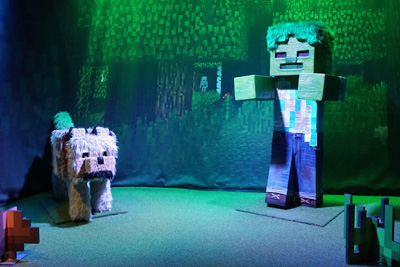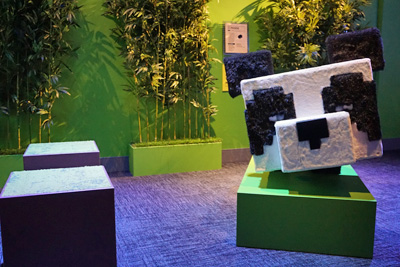
Minecraft is different from other video games. While most are developed “in-house” by billion-dollar corporations, Minecraft was initially crafted by a Swedish software coder named Markus Persson, better known simply as Notch. Instead of perfecting his creation, he released an early version in May 2009 for free to the online video game community. As opposed to relying on investors, Notch then used his personal savings to finetune the game, as well as funds raised through digital preorders. Although the sale began in June 2009, the official release didn’t occur until two years later, by which time Minecraft had already emerged as a cultural phenomenon.
The year 2019 not only marked the tenth anniversary of Minecraft’s initial launch but the premier of Minecraft: The Exhibition, an overview of the game developed by the Museum of Pop Culture (MoPOP) in conjunction with Mojang, the company later formed by Notch. The exhibit opened at the Seattle-based museum in October 2019 before traveling to other locales, including the Liberty Science Center in Jersey City, New Jersey, in 2022.
“We are thrilled to co-create Minecraft: The Exhibition with Mojang and host the world premiere at MoPOP,” Brooks Peck, senior curator of the Museum of Pop Culture, announced at the time. “Minecraft is not only a game that allows for unlimited creativity and exchange of ideas, it also promotes inclusiveness and equality, which are core to MoPOP’s mission.” The exhibit itself transported the block-shaped dynamics of Minecraft into the real world, and gave visitors a history of the game’s development, opportunities to craft their own creations, and an examination of how Minecraft evolved from online entertainment into a source for education and charity efforts.
By initially making Minecraft available for free and keeping users abreast of its development in The World of Notch Tumblr blog, Markus Persson was able to tap into the online gaming community for ideas and expansion of his original concept. Although created by Persson/Notch and then overseen by his company Mojang, Minecraft was in essence co-produced by that fanbase, which was diverse and international in scope. Notch also decided to make the source code available, allowing users to modify – or “mod” – the game to their liking as long as they did not sale their version for profit. Notch likewise looked the other way when it came to file sharing and kept the cost of the official Minecraft far below that of other game manufacturers.
Despite such legal freedoms – or maybe because of the game’s collaborative nature – Minecraft’s registered users increased exponentially from the very start, going from 4,200 in June 2009 to 15,000 just three weeks later, and then reaching 100,000 in January 2010. By 2021, over 238 million copies of the game had been sold worldwide, with 140 million active users, making it the best-selling video game of all time. Because Minecraft does not come with any sort of official instruction manual, online communities have sprung up across the Internet, with fans offering tips and posting videos that highlight their unique creations.
Minecraft allows users to construct their own worlds through the use of “blocks,” which represent everything from sand and wood to gravel and coal. “Players have redrawn Minecraft to suit particular cultures, lifestyles, and historical periods,” Minecraft: The Exhibition explains. “They’ve also added modern cities, science-fiction worlds, and countless other adaptations to alter the look of the game.”
Because of similarities to other “construction” toys from the past and present – such as Lincoln Logs, Tinkertoys, Erector sets, and LEGO bricks – the potential for Minecraft to be used for education purposes was immediately obvious, while the lower cost of Minecraft compared to other video games made it ideal for classrooms. The basic concept of Minecraft, meanwhile, inevitably drew comparisons to the real world. If one could build a better place in Minecraft, users began to realize, why couldn’t the same be done outside the game? The possibilities were not lost on Mojang, which launched a multitude of endeavors that highlight the greater potential of Minecraft.
In 2012, the company teamed with the United Nations agency UN-Habitat and Microsoft to create Block by Block, a charity organization that allows real-world communities to plan and design improvements to their neighborhoods using Minecraft. One specific example highlighted in Minecraft: The Exhibition was the creation of safer streets in the Kim Chung neighborhood of Hanoi. Many teenage girls in the working-class community were forced to walk several miles to school through poorly lit and potentially dangerous areas of the city. Block by Block first organized “safety walks,” in which groups of teenagers identified the most troubling spots. Afterwards the teens used Minecraft to craft recommendations, including the installation of streetlights, trash cans, and better signage. Their proposal was then presented to local government and non-government officials.
Mojang has also used Minecraft for charity efforts. In 2018, for instance, pandas were introduced into the game in collaboration with the World Wildlife Fund to raise awareness of conservation efforts. Mojang then challenged Minecraft players to add ten million bamboo blocks into the game, after which a $100,000 donation was made to the WWF. Another $100,000 donation was made to the Nature Conservancy after ten million coral biorocks were placed in the game. Six actual biorocks – which help corals grow five times faster – that were shaped like characters from Minecraft were likewise installed off the factual coast of Mexico by Mojang.
“Minecraft began as a simple idea: a world made of blocks,” Minecraft: The Exhibition states at its entrance. “Blocks of dirt, blocks of stone, blocks of wood, even blocks of water. In that world, players can build whatever they imagine by breaking and placing those blocks. From these spartan elements emerge an infinity of creations, experiences, and stories.” Minecraft: The Exhibition similarly tells a story by immersing visitors into that block-based world, allowing them to not only explore but become part of the experience – as well as learn, create, and even make the real world a little bit better in the process.
Anthony Letizia





